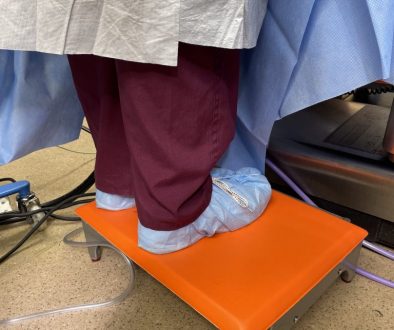Ergonomics and the Pregnant Surgeon
I recently recorded a podcast for Cold Steel and one of the hosts referenced a couple of my blogs during the interview. It made me realize that it had been far too long (12 months) since I had last written one. Time does go by really fast when you’re having fun sharing your passion on the speaking circuit!
Today, I thought I’d write about a topic that I’ve been asked about at many talks – Are there any specific ergonomic tips for pregnant surgeons? I also wanted to advise a junior colleague who has her entire career in front of her and so, I went searching for information.
It came as no surprise to me that there are no studies specifically evaluating work-related MSK symptoms and injuries in pregnant surgeons. However, extrapolating data from other healthcare workers, we do know that pregnancy can create some new ergonomic hazards and exacerbate others.
Pregnant individuals already have issues with back pain and altered gait due to increasing weight and high levels of circulating relaxin and estrogen, which leads to joint laxity, hypermobility and exaggerated spinal curvature. These factors, coupled with an altered center of gravity also increases their risk of falls. In addition, the hormonal and physiological changes lead to edema and lower hand grip strength compared to non-pregnant individuals and grip strength continues to decrease as the pregnancy advances. This means that pregnant healthcare workers are more prone to MSK injuries resulting from repetitive movements compared to non-pregnant workers. Aside from the ergonomic stressors resulting from the intrinsic changes of pregnancy, the work environment, and especially the design of operating room tables and other instruments present additional challenges to optimal ergonomics for the pregnant surgeon.
So, what are some potential solutions? We have to think about how we work and institute administrative controls. Many common surgical work practices such as shift-work, prolonged work hours (including standing long hours) have been associated with poor pregnancy outcomes such as intra-uterine growth retardation, pre-term delivery and gestational hypertension. This article recommends operating as much as possible from a sitting rather than standing position and limiting continuous standing to < 3 hours. I’ve discussed the importance of introducing breaks and stretches into our workdays in a previous blog post and this is an absolute necessity for the physical well-being of the pregnant surgeon. It requires a change in our surgical culture and the difficulties associated with that particular piece are not lost on me. Using non-slip anti-fatigue mats should be mandatory, given the higher fall risk. Some have suggested minimizing laparoscopy and endoscopy during the third trimester, and making liberal use of wrist splints and back belts, in addition to wrist-specific stretches. The recently published American College of Surgeons Ergonomics Taskforce recommendations also suggest using a power grip may help reduce finger/wrist fatigue when working with laparoscopic/endoscopic graspers and this may be especially important for the pregnant surgeon. Using a concave ergonomic desk board attachment reduced back discomfort in pregnant workers during computer work. While adjustable height curved desks have improved ergonomics for all involved, they may be especially useful for pregnant healthcare workers.
Clearly, a lot more research is necessary not only to understand the unique ergonomic stressors faced by pregnant surgeons, but also on strategies to best mitigate the and reduce injury. I recently came across this article on designing a new workstation for pregnant workers in the apparel industry. It made me think about whether a similar modification for our OR tables might make life better for pregnant surgeons. This need for innovation was one of the main reasons I co-founded the Society of Surgical Ergonomics. Join it, if you haven’t already!




